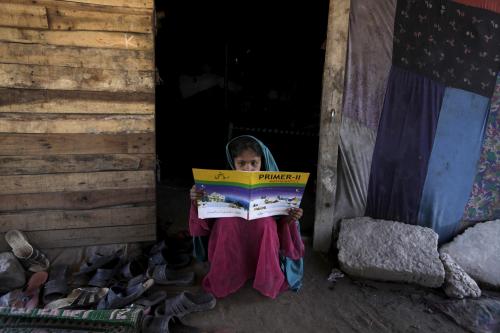Razia with her six children and a drug-addicted husband lives in one room in a three-room compound shared with 20 other people. Pre-COVID-19, all the residents were rarely present in the compound at the same time. However, now they all are inside the house queuing to use a single toilet, a makeshift bathing shed, and a corner of the compound to cook rapidly disappearing food supplies. Razia is just one example of the many women Aappa Aziz Trust works with in the slums of an urban center in Pakistan. Social distancing for women like Razia who are solely responsible for household chores and care is near impossible. Compounded by unhygienic conditions, the vulnerability of these women and their families to COVID-19 is enormous.
Though the COVID-19 epidemic is a nasty equalizer in affecting people of all regions, races, nationalities, genders, and social strata, the impact is not the same for all. The crisis has exposed the gendered fault lines of structural inequalities, hitting hardest those who are already the most browbeaten, the majority of whom are women. To avert compounding structural inequalities, evidence warns against a gender-neutral response to epidemics or pandemics. Despite multiple commentaries and efforts on gender analysis, a gender-sensitive response to the COVID-19 crisis is missing.
The disproportionate burden on women and girls as homemakers and caregivers in families, and as participants in the informal and insecure economy, has been well documented by many, and is acutely seen in the pandemic’s impact on women’s livelihoods.
Without exception, the women that Aappa Aziz Trust serves work as unregistered workers cleaning and washing nearby houses or making paper bags and bed sheet edges for the local cottage industry through middlemen. Fifty percent of these women are the sole breadwinners for their families. The pandemic has severely affected their income, as housemaids have either been laid off or their salaries reduced, and the cottage industry has closed. Middlemen are bringing some work and supplies for women with sewing machines and stitching skills to sew face masks at a very low rate of 7 pence for 12 masks. On average, their income has been reduced to 25 percent of pre-pandemic days. In the battle for survival, putting food in their families’ stomachs is taking precedence over keeping the virus out of their lungs. Reinstating employment opportunities will become a distant second in the pandemic aftermath.
The digital divide
Amid threats to life, health, and livelihoods, the shock wave of the COVID-19 pandemic can also be felt in the digital divide in relation to school closures. Razia’s children and others that Aappa Aziz Trust serves attend the nearby free school run by the Trust, which is currently closed. None of the families have a computer at home, and no woman has a smartphone. Although a few men in these households may have basic smartphones, they would be unlikely to use these devices in support of their children’s continuing education. Online instruction for these children is therefore not an option. Most women in these families are illiterate and unable to guide children’s learning. This suggests that gender inequalities will affect the next generation’s ability to escape poverty due to the pandemic.
In addition, signing up for the government economic relief package, which will pay an equivalent of US$18 per month for three months to people without income due to COVID-19, is online. Women like Razia have neither the means nor the skills to register. While the Aappa Aziz Trust team has helped with online registration, the fact that a social safety net remains unreachable for the most vulnerable is a prime example of a gender-insensitive pandemic response.
A way forward
However, a silver lining is that women who were successfully able to register for the COVID-19 support package have now made their work visible and counted in the official record. The government should use this data to link these women with social insurance and safety nets and prioritize them in post-crisis economic recovery efforts. Additionally, millions of households in Pakistan have television sets at homes. To help bridge the gendered digital divide, television and radio should be used more effectively to raise awareness, share information on economic relief, and offer school instruction during the crisis. These specific gender-sensitive responses will help reach the most marginalized, while general responses like online systems of learning and social safety nets will exclude women like Razia in desperate need of support.







Commentary
A gender-sensitive response is missing from the COVID-19 crisis
April 16, 2020